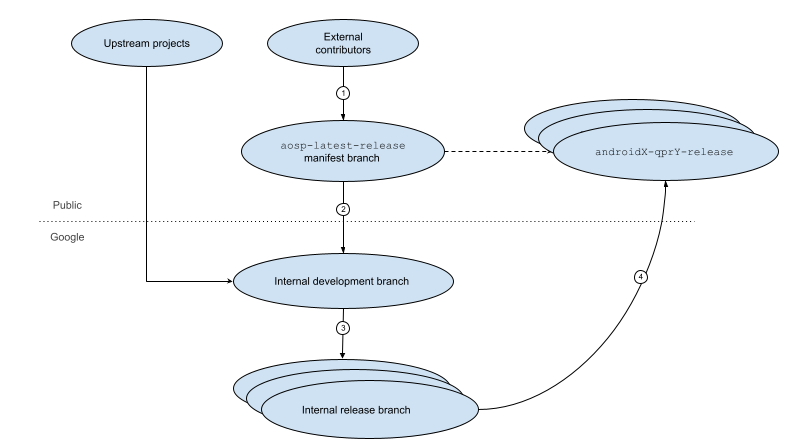کد AOSP قبل از اینکه در یک نسخه رسمی ترکیب شود از طریق شاخه های مختلف حرکت می کند. شکل 1 مراحل مختلف چرخه عمر انتشار را نشان می دهد:

شکل 1. چرخه عمر انتشار AOSP.
مراحل زیر در چرخه حیات آمده است:
مشارکتکنندگان خارجی میتوانند آخرین شعبه انتشار را برای دستگاه خود دانلود و تغییر دهند، و همچنین تغییرات کد را برای نسخه بعدی AOSP در این شاخه پیشنهاد دهند.
برای اطلاعات در مورد چرخه عمر پروژه های بالادستی، چرخه عمر پروژه های بالادستی را ببینید.
Google بررسی میکند و در صورت پذیرش، تغییرات پیشنهادی را در آخرین شعبه انتشار در شاخه توسعه داخلی Google انتخاب میکند. این شعبه فقط در Google قابل دسترسی است و جایی است که Google ویژگی های جدیدی را برای نسخه بعدی اضافه می کند.
به صورت دوره ای، یک شاخه انتشار داخلی از شاخه توسعه داخلی ایجاد می شود. ممکن است Google تغییراتی را در این شاخه انتشار برای رفع اشکالات و بهبود عملکرد انتخاب کند.
در برخی مواقع، گوگل کد را از شاخه انتشار داخلی به آخرین شاخه انتشار (که در مانیفست
android-latest-releaseمشخص شده است) فشار می دهد تا یک کپی فقط خواندنی از شاخه انتشار در میزبان عمومی AOSP ایجاد کند.
چرخه عمر پروژه های بالادستی
کد پروژه بالادستی به شاخه توسعه داخلی جریان می یابد و مراحل 3 و 4 را در نمودار قبلی دنبال کنید. کد بالادستی در شعبه انتشار بعدی منتشر شده است. پروژه بالادستی یک پروژه منبع باز است که AOSP از آن کد می گیرد. علاوه بر پروژه هایی مانند هسته لینوکس و WebKit، گوگل برخی از پروژه های نیمه مستقل اندروید مانند ART، ابزار Android SDK و Bionic را به AOSP منتقل می کند. شما می توانید به طور مستقیم به برخی از پروژه های بالادستی کمک کنید. برای جزئیات، به مشارکت در پروژه بالادستی مراجعه کنید.

